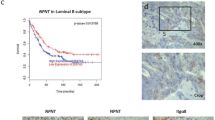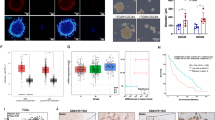Abstract
Endoglin is a cell-surface adhesion protein as well as a coreceptor for transforming growth factor-β (TGF-β). It is located on endothelial and few other cells, but also found on certain tumor cells. Brain metastatic breast tumor cells derived from the MDA-MB-231 cell line heavily express endoglin in contrast to the corresponding parental ones. To clarify whether this determines their invasive phenotype, we compared their biological properties with endoglin-silenced brain-metastatic cells, low-expressing parental cells and these transfected with L- and S-endoglins, isoforms transducing or lacking TGF-β signals. All L-endoglin-overexpressing cells were characterized by numerous invadopodia where endoglin was preferentially localized. Endoglin-expression resulted in elevated levels of the matrix metalloproteinases (MMP-1 and MMP-19) and downregulation of the plasminogen activator inhibitor-1. In Boyden-chamber and wound-healing assays, endoglin-overexpressing cells showed a considerably higher migration and chemotaxis to TGF-β. In 3D spheroid confrontation assays between breast tumor cells and TGF-β-secreting glioma cells, high L-endoglin-expressing cells invaded into the glioma-spheroids whereas low-endoglin-expressing cells dissociated in the culture; invasion was blocked by TGF-β antibodies. In contrast to parental cells, endoglin-overexpressing cells invaded deeply into mouse brain slices. Thus, endoglin expression on tumor cells enhances their invasive character by formation of invadopodia, extracellular proteolysis, chemotaxis and migration.
This is a preview of subscription content, access via your institution
Access options
Subscribe to this journal
Receive 50 print issues and online access
$259.00 per year
only $5.18 per issue
Buy this article
- Purchase on Springer Link
- Instant access to full article PDF
Prices may be subject to local taxes which are calculated during checkout





Similar content being viewed by others
Abbreviations
- FCS:
-
fetal calf serum
- GAPDH:
-
glyceraldehyde-3-phosphate dehydrogenase
- MMP:
-
matrix metalloproteinase
- RT–PCR:
-
reverse transcription PCR
- PAI-1:
-
plasminogen activator inhibitor-1
- TGF:
-
transforming growth factor
References
Andre F, Cabioglu N, Assi H, Sabourin JC, Delaloge S, Sahin A et al. (2006). Expression of chemokine receptors predicts the site of metastatic relapse in patients with axillary node positive primary breast cancer. Ann Oncol 17: 945–951.
Beck IM, Muller M, Mentlein R, Sadowski T, Mueller MS, Paus R et al. (2007). Matrix metalloproteinase-19 expression in keratinocytes is repressed by transcription factors Tst-1 and Skn-1a: implications for keratinocyte differentiation. J Invest Dermatol 127: 1107–1114.
Bowden ET, Barth M, Thomas D, Glazer RI, Mueller SC . (1999). An invasion-related complex of cortactin, paxillin and PKCμ associates with invadopodia at sites of extracellular matrix degradation. Oncogene 18: 4440–4449.
Djonov V, Högger K, Sedlacek R, Laissue J, Draeger A . (2001). MMP-19: cellular localization of a novel metalloproteinase within normal breast tissue and mammary gland tumours. J Pathol 195: 147–155.
Fidler IJ . (2003). The pathogenesis of cancer metastasis: the ‘seed and soil’ hypothesis revisited. Nat Rev Cancer 3: 1–6.
Fonsatti E, Altomonte M, Nicotra MR, Natali PG, Maio M . (2003). Endoglin (CD105): a powerful therapeutic target on tumor-associated angiogenetic blood vessels. Oncogene 22: 6557–6563.
Fonsatti E, Del Vecchio L, Altomonte M, Sigalotti L, Nicotra MR, Coral S et al. (2001). Endoglin: an accessory component of the TGF-beta-binding receptor-complex with diagnostic, prognostic, and bioimmunotherapeutic potential in human malignancies. J Cell Physiol 188: 1–7.
Forstreuter F, Lucius R, Mentlein R . (2002). Vascular endothelial growth factor (VEGF) induces chemotaxis and proliferation of microglial cells. J Neuroimmunol 132: 93–98.
Friedl P, Wolf K . (2003). Tumour-cell invasion and migration: diversity and escape mechanisms. Nat Rev Cancer 3: 362–374.
Gougos A, Letarte M . (1990). Primary structure of endoglin, an RGD-containing glycoprotein of human endothelial cells. J Biol Chem 265: 8361–8364.
Held-Feindt J, Lütjohann B, Ungefroren H, Mehdorn HM, Mentlein R . (2003). Interaction of transforming growth factor-β (TGF-β) and epidermal growth factor (EGF) in human glioma cells. J Neurooncol 63: 117–127.
Kousidou OC, Roussidis AE, Theocharis AD, Karamanos NK . (2004). Expression of MMPs and TIMPs genes in human breast cancer epithelial cells depends on cell culture conditions and is associated with their invasive potential. Anticancer Res 24: 4025–4030.
Lastres P, Martin-Perez J, Langa C, Bernabeu C . (1994). Phosphorylation of the human-transforming-growth-factor-beta-binding protein endoglin. Biochem J 301: 765–768.
Ludwig A, Schulte A, Schnack C, Hundhausen C, Reiss K, Brodway N et al. (2005). Enhanced expression and shedding of the transmembrane chemokine CXCL16 by reactive astrocytes and glioma cells. J Neurochem 93: 1293–1303.
Mazar AP, Henkin J, Goldfarb RH . (1999). The urokinase plasminogen activator system in cancer: implications for tumor angiogenesis and metastasis. Angiogenesis 3: 15–32.
Mentlein R, Forstreuter F, Mehdorn H M, Held-Feindt J . (2004). Functional significance of vascular endothelial growth factor receptor expression on human glioma cells. J Neurooncol 67: 9–18.
Muñoz-Nájar UM, Neurath KM, Vumbaca F, Claffey KP . (2006). Hypoxia stimulates breast carcinoma cell invasion through MT1-MMP and MMP-2 activation. Oncogene 25: 2379–2392.
Palmieri D, Bronder JL, Herring JM, Yoneda T, Weil RJ, Stark AM et al. (2007). Her-2 overexpression increases the metastatic outgrowth of breast cancer cells in the brain. Cancer Res 67: 4190–4198.
Postiglione L, Di Domenico G, Caraglia M, Marra M, Giuberti G, Del Vecchio L et al. (2005). Differential expression and cytoplasm/membrane distribution of endoglin (CD105) in human tumour cell lines: implications in the modulation of cell proliferation. Int J Oncol 26: 1193–1201.
Stark AM, Tscheslog H, Buhl R, Held-Feindt J, Mehdorn HM . (2005). Surgical treatment for brain metastases: prognostic factors and survival in 177 patients. Neurosurg Rev 28: 115–119.
Stark AM, Anuszkiewicz B, Mentlein R, Yoneda T, Mehdorn HM, Held-Feindt J . (2007). Differential expression of matrix metalloproteinases in brain- and bone-seeking clones of metastatic MDA-MB-231 breast cancer cells. J Neurooncol 81: 39–48.
Steeg PS . (2006). Tumor metastasis: mechanistic insights and clinical challenges. Nat Med 12: 895–904.
Stoppini L, Buchs PA, Muller D . (1991). A simple method for organotypic cultures of nervous tissue. J Neurosci Methods 37: 173–182.
Weaver AM . (2006). Invadopodia: specialized cell structures for cancer invasion. Clin Exp Metastasis 3: 97–105.
Weil R, Palmieri D, Bronder JL, Stark AM, Steeg PS . (2005). Breast cancer metastasis to the central nervous system. Am J Pathol 167: 913–920.
Yoneda T, Williams PJ, Hiraga T, Niewolna M, Nishimura R . (2001). A bone-seeking clone exhibits different biological properties from the MDA-MB-231 parental human breast cancer cells and a brain-seeking clone in vivo and in vitro. J Bone Miner Res 16: 1486–1495.
Acknowledgements
This work was supported by grants of ‘Universitätsklinikum Schleswig-Holstein Campus Kiel’ (JH-F and RM) and the State of Schleswig-Holstein ‘Molecular Imaging in the North MOIN’ (RM). We thank Martina Burmester, Dagmar Freier, Miriam Lemmer and Ursula Prange for their expert technical assistance.
Author information
Authors and Affiliations
Corresponding author
Rights and permissions
About this article
Cite this article
Oxmann, D., Held-Feindt, J., Stark, A. et al. Endoglin expression in metastatic breast cancer cells enhances their invasive phenotype. Oncogene 27, 3567–3575 (2008). https://doi.org/10.1038/sj.onc.1211025
Received:
Revised:
Accepted:
Published:
Issue Date:
DOI: https://doi.org/10.1038/sj.onc.1211025
Keywords
This article is cited by
-
Isopimpinellin extends antiangiogenic effect through overexpression of miR-15b-5p and downregulating angiogenic stimulators
Molecular Biology Reports (2022)
-
Apoptosis and metastasis inhibitory potential of pineapple vinegar against mouse mammary gland cells in vitro and in vivo
Nutrition & Metabolism (2019)
-
Endoglin (CD105) Silencing Mediated by shRNA Under the Control of Endothelin-1 Promoter for Targeted Gene Therapy of Melanoma
Molecular Therapy - Nucleic Acids (2015)
-
The Role of Hypoxia and Cancer Stem Cells in Renal Cell Carcinoma Pathogenesis
Stem Cell Reviews and Reports (2015)
-
PRH/HHex inhibits the migration of breast and prostate epithelial cells through direct transcriptional regulation of Endoglin
Oncogene (2014)



